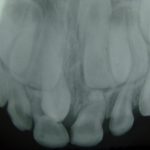
The presence of supernumerary teeth is considered to be the commonest cause for the failure of eruption of maxillary incisors. Supernumerary teeth are most common in the anterior maxilla with a reported prevalence of 2.6% resulting in delayed or failed eruption in 43% of affected maxillary central incisors. Management usually involves surgical removal with or without space maintenance and/or orthodontic traction. It is estimated that between 30-54% required an additional surgical intervention after supernumerary removal alone.
The aim of this review was to assess the percentage of impacted maxillary incisors that successfully erupt after surgical removal of supernumerary teeth with or without other interventions.
Methods
A protocol for the review was registered on the PROSPERO database. Searches were conducted in the Cochrane Library, Medline/PubMed, Virtual Health Library (including Bibliography Brazilian Dentistry and LILACS), Scopus, ISI Web of Knowledge, Embase, ClinicalTrials.gov, the Directory of Open Access Journals, Digital Dissertations, the metaRegister of Controlled Trials, WHO trials search portal, and Google Scholar databases. Two reviewers independently screened and selected studies with 3 authors independently extracting data. Risk of bias was assessed independently by two reviewers using the Risk Of Bias In Nonrandomized Studies of Interventions (ROBINS-I) tool and the Newcastle-Ottawa scale . A random effects meta-analysis of the data was conducted.
Results
- 15 studies (14 retrospective, 1 prospective).
- 5 studies were considered to be at high risk of bias, 9 at moderate risk and one at low risk.
- In the 14 retrospective studies 980 patients were included with 996 supernumeraries reported associated with 945 impacted incisors.
- The primary treatment in all studies was surgical removal of the supernumerary.
- The single prospective study included 62 patients with 74 impacted incisors with successfully eruption in 39 patients following surgical removal of the supernumerary.
- Meta-analysis found a pooled estimate for successful eruption of unerupted maxillary incisors after removal of an associated supernumerary tooth only was 57.6% (95%CI; 47.8 to 67.0%) with a higher percentage with the use of space measures and orthodontic traction (see table below).
| Procedure | No. of studies | Eruption success (95%CI) | Prediction Interval |
| Supernumerary removal | 11 | 57.6% (47.8 to 67.0%) | 23.1% to 88.4% |
| Supernumerary removal with space measures | 1 | 82.4% (65.5 to 93.2%) | _ |
| Supernumerary removal with orthodontic traction | 1 | 96.9% (83.8 to 99.9%) | _ |
- Subgroup analysis showed higher eruption percentages with conical type supernumeraries compared with odontomas (see table below).
| Type of supernumerary | No. of studies | Eruption success (95%CI) | Prediction Interval |
| Odontoma | 4 | 34.4% (18.5 to 51.9%) | 4% to 72.4% |
| All other types of supernumerary | 9 | 61.1% (49.5 to 72.1%) | 21.8% to 93.6% |
| Tuberculate type | 6 | 44.7% (28.6 to 61.4%) | 2.1% to 93.1% |
| Conical type | 6 | 72.2% (60.0 to 83.0%) | 33.0% to 98.6%) |
Conclusion
The authors concluded: –
Limited evidence indicated that the adjunctive use of orthodontic measures and removal of supernumerary teeth might be associated with greater odds of successfully impacted incisor eruption than removal of the supernumerary tooth alone. Certain characteristics related to supernumerary type and the position or developmental stage of the incisor may also influence successful eruption after removal of the supernumerary. However, these findings should be viewed with caution as our certainty is very low to low because of bias and heterogeneity.
Comments
The authors registered their protocol in PROSPERO and searched a wide range of databases with no language restrictions. However all but one of the included studies are retrospective in design so at increased risk of bias with the single prospective study being the only included study considered to be at low risk of bias. Meta-analysis suggests a mean eruption success of 57.6% (95%CI; 47.8 to 67.0%) following surgery alone although the prediction interval indicates a widespread for effect size of 23.1% to 88.4%. The findings also suggest different success rates with different types of supernumerary and two small studies indicated higher eruption success rates with additional orthodontic measures. While this review provides initial data for eruption success following removal of supernumerary teeth the certainty of evidence is only very low to low. Additional high-quality prospective studies are needed and at least one randomised controlled trial has been registered ( Sheehra et al., 2022).
Links
Primary Paper
Seehra J, Mortaja K, Wazwaz F, Papageorgiou SN, Newton JT, Cobourne MT. Interventions to facilitate the successful eruption of impacted maxillary incisor teeth due to the presence of a supernumerary: A systematic review and meta-analysis. Am J Orthod Dentofacial Orthop. 2023 May;163(5):594-608. doi: 10.1016/j.ajodo.2023.01.004. Epub 2023 Mar 11. PMID: 36907703.
Other references
Seehra J, DiBiase AT, Patel S, Stephens R, Littlewood SJ, Spencer RJ, Frawley T, Benson PE, Ireland AJ, Parvizi F, Atack N, Kidner G, Wojewodka G, Ward C, Papageorgiou SN, Newton JT, Cobourne MT. Study protocol for the management of impacted maxillary central incisors: a multicentre randomised clinical trial: the iMAC Trial. Trials. 2022 Sep 16;23(1):787. doi: 10.1186/s13063-022-06711-0. PMID: 36114553; PMCID: PMC9479226.
Picture credits
Public Domain, Link
